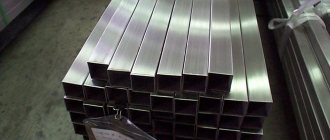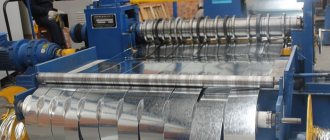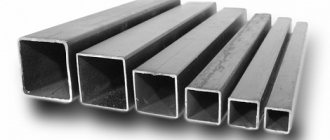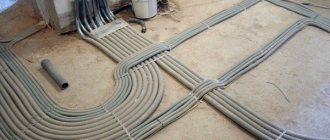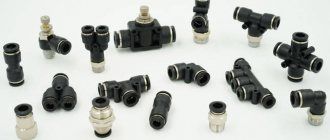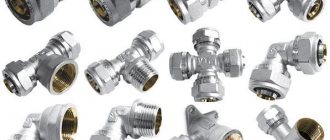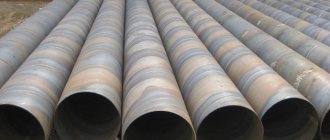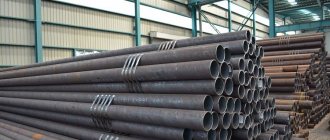Pipe production methods
Stainless steel pipes are a derivative product of rolled metal. Based on the production method, the following types of stainless pipes are distinguished:
- Hot-deformed;
- Cold-worked;
- Heat deformed;
Products can be made from flat rolled products, which are subjected to technological bending and subsequent welding. Welded pipes are produced in this way. For seamless pipes, the starting material is a stainless steel circle, and in this case, piercing, rolling and calibration are used in the manufacture of the pipe. Stainless steel seamless pipe as a solid product has increased strength and high mechanical properties.
Features of stainless steel
Having considered the features of the geometric shape of the pipes, attention should be paid to the features of the steel used. Stainless steel is a type of alloy steel, the corrosion resistance of which is increased by increasing the concentration of chromium in the composition to 12% or higher. If oxygen is present, an inert film is created on the surface around the product, which can protect it from exposure to high humidity. However, it is worth considering that stainless steel can have very different resistance to chemical and mechanical stress.
Classification
Stainless steel pipes vary in geometric characteristics depending on the diameter and cross-sectional shape of the pipe, as well as the type of surface treatment. The cross-sectional shape of the pipes can be round, square and rectangular. According to the type of processing, they are divided into:
- Matte
- Sanded
- Polished
The thickness of the pipe wall allows stainless steel pipes to be divided into thick-walled with great strength and thin-walled. Thin-walled pipes are characterized by high flexibility, so they are necessary for the manufacture of complex structures.
Section geometry
When choosing pipes, the first thing you should pay attention to is the geometry of the section. During construction, profile pipes are often used. The section geometry determines the main operational characteristics:
- Difficulty in carrying out installation work.
- Efficiency of the created system.
- Product cost.
Note that pipes of the same geometry can be produced using a variety of methods, which determines the labeling, cost of the product and other operational characteristics.
Round section
The most widespread are pipes with a round profile due to the fact that this shape has the highest aerodynamics. The production of pipes with a round cross-section can be carried out using rolled sheet steel or using seamless technology.
Electric-welded round pipes according to the production method are divided into the following groups:
- Straight-seam.
- Spiral seam.
Straight seam can be characterized by the fact that they can withstand a small load.
Pipes with a spiral seam can have a diameter from 530 to 1420 mm. Scope of application: various industries, road construction, creation of industrial pipelines. Conventionally, they can be divided into the following groups:
- General purpose.
- For use in the construction of oil and gas pipelines.
- Creation of highways.
Straight-seam versions have diameters from 16 to 1,420 mm. Conventionally, they are divided into the following groups:
- To create highways.
- General purpose.
- For laying oil and gas pipelines.
Considering pipes that have seams, we note that despite the improvement of production methods, it is the place where the metal joins that has the least strength: the joint is the place where the load is concentrated. To increase the strength of pipes, a seamless production method was developed.
The seamless design is distinguished by the fact that it has the same strength indicator along the entire length. The peculiarities of this production method are that the product is obtained by pulling it from a hot billet. In addition, the cold rolling method can be used, which has quite a few features.
The drawing method is more suitable for the production of small diameter pipes. This is due to the peculiarities of production technology. Products with large diameters are produced by cold rolling. Seamless pipes are often used in the petrochemical industry, since such pipelines are subject to great demands.
Profile pipes
The profile version of pipes is characterized by the fact that it has a rectangular, square or oval cross-section. Increased resistance to deformation and corrosion leads to widespread use in construction. When using steel with a high thickness index, the resulting product is quite durable.
The most common cross-sectional shapes of the profile pipe are:
- Square. In the production of this version, hot-rolled strip is used, which is supplied in accordance with GOST 8639-82. Section dimensions vary from 15 by 15 mm to 300 by 300 mm. Pipes of this type are used to create supports, racks and frames. Large square pipes are suitable for a wide variety of construction work to create structures that will be subject to mechanical loads.
- Rectangular. Rectangular stainless steel pipes are produced in accordance with GOST 8645-68. The section is classified by size into small (from 20 by 10 mm to 50 by 40 mm), medium (from 60 by 30 mm to 120 by 80 mm), large (from 140 by 60 mm to 200 by 100 mm). Pipes with a rectangular cross-section are more popular than those with a square cross-section. This is due to the lower cost, as well as the ability to distribute the load.
- Oval. Oval-shaped pipes are quite rare; they are mainly used to create ventilation systems. The oval shape determines the uneven distribution of the load.
Today on the construction market there are a huge number of varieties of profile pipes, which allows you to select the most suitable design options.
Application of stainless pipes
Pipes today are indispensable in various fields: in the food industry, mechanical engineering, petrochemical and mining industries, etc. They are used for laying utilities and pipelines transporting, among other things, aggressive gases and liquids.
Passat LLC supplies seamless and welded stainless steel pipes, round and profile sections.
| SEAMLESS PIPES | ELECTRIC WELDED PIPES | PROFILE PIPES |
The range includes stainless steel pipes of the following steel grades: AISI 201, AISI 202, AISI 304, AISI 321, AISI-316L, AISI-316Ti, AISI 409, AISI 430, of various standard sizes (square from 20x20mm to 300x3000mm, rectangular from 10x20mm to 40 0x200mm, round diameter from 10mm to 300mm), and surface types (polished, mirror, matte).
Popular brands
To begin with, let us pay attention to the fact that in Russia they produce quite a lot of different grades of stainless steel, which are later used in the production of pipes. However, the most popular ones are produced abroad: 300 and 400 series. Such steel grades have high corrosion resistance and do not react to aggressive environments. Also, grades 300 and 400 have increased ductility and strength. However, we note that recently the 200 brand has been catching up in terms of popularity with 300 and 400 due to its low cost and fairly high strength.
Characteristics of electric welded pipes
International standards: electric welded pipes made of austenitic steel grades ASTM A554, A270, A312, A249, A269, DIN 17457, 17455 Seam welding type - TIG, laser seam. Surface: • Matte • Sanded (180, 320, 400 Grit) • Mirror (400,600 Grit)
Symbols for determining the surface type of an electric-welded pipe
| Surface type | Designation | |
| Matte | Matt, Mill finish | Matte |
| Sanded | Brushed | Cleaned, primary grinding |
| Satin 180 Grit Satin 320 Grit Satin 400 Grit | Grinding degree | |
| Mirror | Mirror 400 Grit Mirror 600 Grit | Polishing degree |
Shape: • round • profile Length: 6 m (custom pipes of any length can be supplied to order). Standard sizes: • diameter from 6 mm to 325 mm • cross-section from 10x10mm to 300x300mm, 400x200mm Wall thickness: from 0.8 mm to 6 mm
Areas of use
It should be noted that the areas of application of stainless pipes, as a rule, are established by GOSTs; it is in such documents that they describe in detail in what areas certain types of pipes can be used.
You can indicate the areas where the described products are most widespread:
- chemical;
- automobile;
- food;
- medical, etc.
There are certain restrictions on the use of certain types of stainless pipes in certain areas of industry. For example, welded pipes cannot be used in areas where the medium passes under high pressure, through which hazardous pipes are transported. It's clear. The presence of a seam is a minus in the area of safety.
If the pipes do not need to be put on display, as they say, then you can use the matte look of stainless steel. Mirror pipes will look attractive in areas of systems exposed to public display. Designers and people involved in furniture production love mirrored stainless pipes.
Application of profile pipes
Profile pipes are not used as often as pipes with a round cross-section. But you often can’t do without them. Their main advantage is light weight. Therefore, such products are used in production:
- frames;
- various arches;
- columns
Areas of application of electric welded pipes
• Heat exchangers and heaters • Decorations, structures • Petroleum and chemical industry • Food industry • Shipbuilding and mechanical engineering • Water transportation systems
Product standards, according to intended use (welded stainless steel pipes)
| USAGE | EN Euro Norm | SS | ASTM-ASME | DIN | NFA | GOST |
| Chemical industry | EN 10217-7 | 219711 219713 | A 358-SA 358 A 312-SA312 A 269-SA 269 | 17457 | 49147 | GOST 11068-81 |
| Food products | EN 10217-7 | A 270 | 11850 | 49249 | ||
| Heat exchanger | EN 10217-7 | 219711 219713 | A 249-SA 249 | 17457 2818 | 49247 49244 | GOST 11068-81 |
| Pipeline | EN 10217-7 | A 778 A 269 | 17455 | 49147 | ||
| Drinking water | EN 10312 | DVGW541 | ||||
| Decoration, design | EN 10296-2 | A 554 | 17455 2395 | 49647 |
200 grade stainless steel
We will also pay attention to 200 series steel. Despite its lower performance qualities, this alloy has now become extremely often used in the production of pipes for various applications. An example is AISI 201, an alloy that has a low cost compared to others. In the production of this steel, nitrogen and manganese are used instead of expensive nickel. As practice shows, the alloy in question is not inferior in its performance qualities to the AISI 304 and AISI 321 brands. That is why this type of steel is used in the manufacture of profile and round pipes, which are used to create drinking and domestic water supply systems, as well as drainage and ventilation.
Characteristics of seamless pipes
International standards:
- ASTM A312 - Seamless pipes (c/c) of austenitic stainless steel grades,
- ASTM A213 - Seamless Ferritic and Austenitic Alloy Boiler Parts,
- steam superheating and heat exchange pipes.
Surface: Matte Shape: round Length: 5-7m Standard sizes: diameter from 6 mm to 325 mm Wall thickness: from 1 mm to 13 mm
Application areas of seamless pipes
• General purpose pipes, chemical. and nuclear industry • Heat exchangers • Furnaces and chimneys
400 grade stainless steel
This type of alloy has a narrower range than the previous one. The peculiarities of this group are the high chromium content in the composition. At the same time, no other alloying substances are added to the composition, which has a beneficial effect on the cost of the material. When producing pipes that must have high ductility, the AISI 430 grade is used. Its features include the following points:
- The composition includes a large amount of chromium.
- Carbon has low concentration.
This composition determines a high strength index and at the same time ductility. This brand is used to create pipes by welding or casting. Products made from AISI 430 are widely used in the oil and gas industry; the surface does not react to temperature changes.
Product standards, according to intended use (seamless stainless steel pipes)
| usage | GOST | International standard |
| General purpose pipes | GOST 9940-81, GOST 9941-81 | ASTM A312 |
| Heat exchange pipes | GOST 9941-81 (measured) | ASTM A213, DIN 17458-85, ASTM SA268, ASTM A269 |
| Instrument pipes | GOST 19277-73, GOST 10498-82, GOST 14162-79, | DIN 17458-85 |
| Boiler pipes | TU 14-3R-55-2001, TU 14-3-460-75, TU 14-3R-197-2001 | |
| Pipes for furnaces | GOST 9940-81, GOST 9941-81, m/s 10Х23Н18, 15Х25Т, | ASTM A312, m/sTP 310S |
Profile pipes
Each type of profile pipe has its own GOST. So there is a GOST for:
- square;
- rectangular;
- oval pipes.
So square pipes have an outer cross-sectional diameter from 10 to 180 mm. Wall thickness varies from 1 to 14 mm. Approximately the same indicators are typical for rectangular products.
Oval pipes have a slightly smaller diameter and may have thinner walls - up to 0.5 mm.
The length of profile pipes can range from 1.5 to 9 meters, less often – 11 m.
Radioactivity
Let’s not ignore the radioactive safety of used tubing pipes. Our company purchases pipes only from fields belonging to the northern regions (Yamalo-Nenets Autonomous Okrug, Khanty-Mansi Autonomous Okrug). The advantages of such products are obvious:
- no wall wear;
- the aesthetics and durability of such products can be equated to new pipes.
But there is also a minus - a relatively high purchase price, as well as high transportation costs. But we know that the pipes we propose will not emit radiation, since oil fields located in the northern regions, as a rule, do not pose a radiation hazard.
Many companies producing fences offer posts made from tubing pipes brought from the southern regions (Samara, Tatarstan, Bashkiria). Such products are much lower in purchase and this is due to the wear and tear of the wall, as well as inexpensive delivery to the capital. But, recently, information has appeared that a batch of tubing pipes that were susceptible to radioactive contamination entered the market. Of course, such products should not enter the secondary market, since the continued use of such pipes is dangerous to life. It is also worth noting that they should not be transported outside the territory of the deposit, not to mention the region. But many turn a blind eye to this. Due to this feature, we carry out personal radio monitoring of pipes that arrive at our warehouse from the fields, so we can guarantee that our products are absolutely safe. If the buyer wishes, we can measure the radiation level in his presence.
The radiation indicator of tubing pipes offered by our company is 0.10-0.20 μ3v/h with a standard value of 0.40. Reliability, strength and durability, safety - all these characteristics are possessed by our fences made from posts purchased by us. If we take into account the quality of our products, as well as their cost, then you will not find a more advantageous offer than ours.
| Go to the selection of poles for the fence from tubing pipes |
Seamlessness of used tubing pipes
When welding is carried out, the metal raw material is subject to significant changes, namely, the homogeneity of the metal structure is disrupted, and concentrations of high physical and chemical stresses are formed. Surely many have seen when, when bending welded pipes, the product is destroyed in the weld zone. When used in a fence, such a pipe begins to rust (corrode) almost immediately after installation. Due to the rather large chemical stresses caused by welding, corrosion reactions proceed an order of magnitude faster along the welds. This process spreads most quickly in the zone of transition of the installed column from the underground to the above-ground state, where the constant presence of oxygen and humidity creates an excellent environment for corrosion.
What is more unpleasant is that it is in this zone that stresses from loads (primarily due to wind) acting on the fence structure are concentrated. Based on this, it can be noted that a welded pipe will be destroyed an order of magnitude faster compared to a seamless one. The production of tubing pipes is carried out using round heated blanks using the method of broaching and piercing. Welding is completely eliminated in the production process. It is thanks to this factor, combined with the considerable thickness of the wall, that fence posts made from tubing pipes are characterized by a service life of at least 50 years.
What is included in stainless steel?
chemical composition of stainless steel
A few words about the “ingredients” used in the “cooking” of stainless steel. Or more precisely about alloying elements and their properties. By the way, steel is divided according to the degree of alloying. Austenitic corrosion-resistant steels are classified as high-alloy steels, since the total mass fraction of alloying elements is at least 10%, and the iron content is more than 45%. Let's continue the story about austenitic high-alloy chromium-nickel stainless steel 08Х18Н10, also known as AISI 304, which has alloying elements totaling approximately 28% (18% chromium and 10% nickel). This stainless steel is an alloy in which chromium (Cr) with nickel (Ni) and several other elements are added to iron (Fe) and carbon (C) during smelting. Carbon is responsible for hardness and strength, reducing toughness and ductility. A high carbon content will begin to reduce the cold brittleness threshold and can lead to difficulty welding the metal. Directly in imported stainless steel AISI 304, in contrast to its domestic counterpart, the percentage of carbon is much lower. Chromium in the alloy plays the role of the main “defender” in the fight against corrosion caused by exposure to aggressive environments and various temperatures. Since, thanks to chromium interacting with oxygen, a thin passive film of chromium (III) oxide Cr2O3 is formed due to the adsorption of oxygen occurring on the surface without destroying the crystal lattice of the original metal. This passive film, uniform in composition and evenly distributed over the entire surface of the metal, contributes to the appearance of stainless properties. Chromium, interacting with nickel, provides a stable austenitic structure, which contributes to high ductility, hardenability, good stampability and weldability of products. Nickel increases corrosion properties and prevents metal grain growth when heated. Chromium also increases the heat resistance of nickel, which, in turn, lowers the threshold of cold brittleness, which allows the use of stainless steel 08Х18Н10 in the temperature range from cryogenic -196 °C to high 800 °C. At temperatures above this value, metal oxidation occurs, accompanied by scaling and decarburization of the steel with complete volatilization of the protective passive film.
Speaking about the contact of AISI 304 stainless steel with food, I would like to note the influence of chromium and nickel. The combination of these two components in the alloy increases the corrosion properties and allows the use of products in aggressive environments. Although each product on store shelves has its own acidity levels, the acidic environment formed during the cooking process when interacting with stainless steel, even under the influence of temperatures during heat treatment of products, becomes insufficiently aggressive to affect or damage the integrity of the protective passive film layer , with which the steel is coated. And this, in turn, prevents the release of any harmful impurities from the metal that can interact with products. Therefore, steel can come into contact with food without any consequences.
